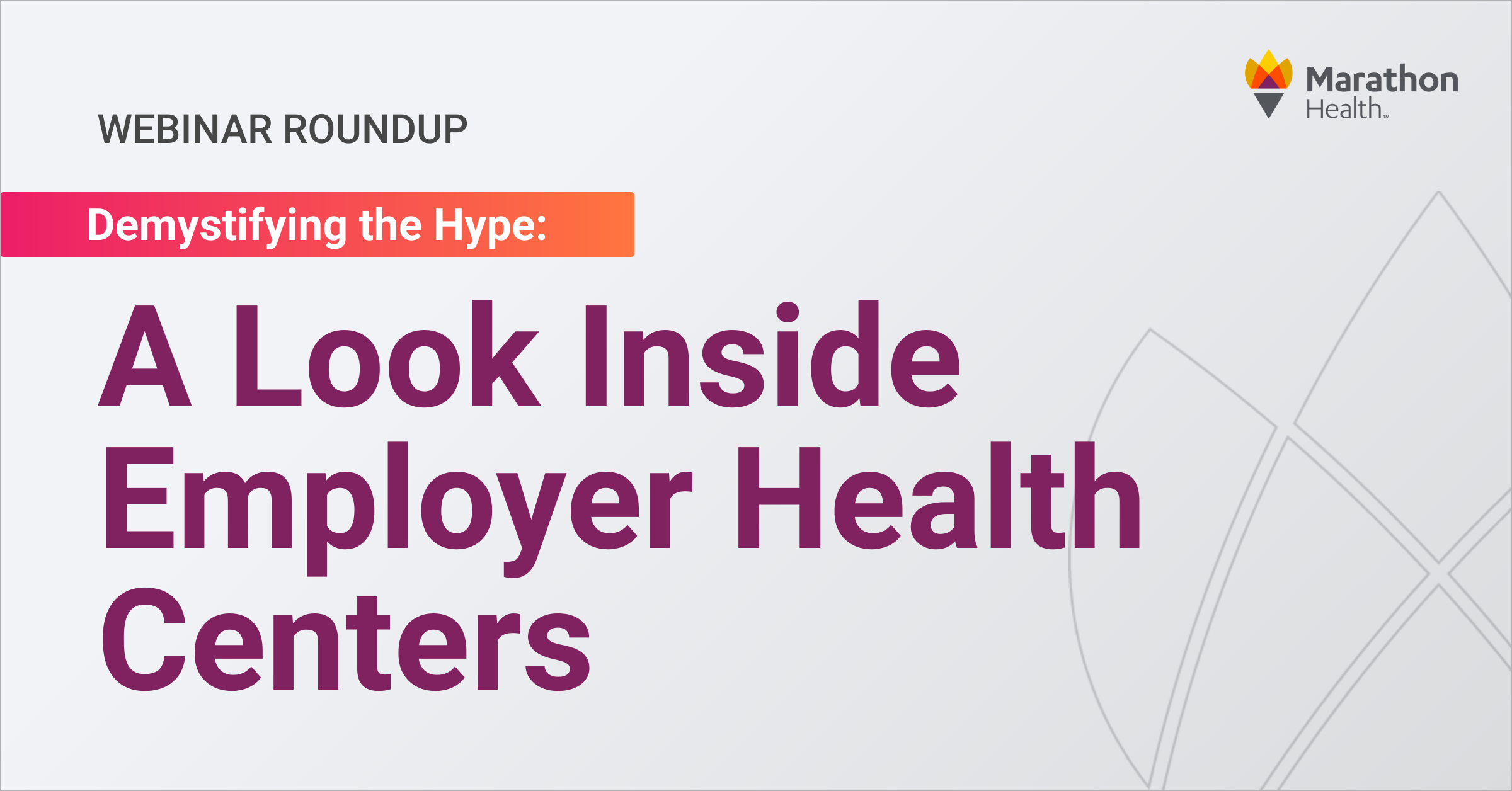Employer health centers continue to grow in popularity, but many still don’t understand how they differ from a typical primary care doctor. While employers often believe their workers have a primary care doctor, one-third of Americans (100 million) don’t, according to a report by the National Association of Community Health Centers. Oftentimes, patients may see a doctor once or twice a year, but they aren’t truly managing or improving their health.
Employer-sponsored health centers focus on dedicated care teams empowering patients to live better. Almost 60% of patients who have a high-risk health condition who leverage their Marathon Health center are making improvements on quality measures, such as lowering their blood pressure and A1c. Because of this, employers are saving up to 20 to 30% for each patient who is engaging with the health center.
During our webinar, Demystifying the Hype: A Look Inside Employer Health Centers, Katie Vicars, Senior Vice President of Client Development for Marathon Health, talked to clinical leaders to dig deeper into the ways care teams take time to build trusted relationships to help employees and their families improve their health, while also discussing what quality care and success looks like for both patients and their employer.
The roundtable discussion includes great insights from:
- Sue Ferbet, MSN, FNP, Regional VP, Client Care Team Operations, Marathon Health
- Silvia Madrigal, FNP, Regional VP of Clinical Leadership, Marathon Health
- Dr. Amy Sachau, Market Clinical Lead, Marathon Health
Watch the Full Webinar — Demystifying the Hype: A Look Inside Employer Health Centers
What Does Success Look Like at an Employer Health Center?
Katie kicked off the discussion by asking the panelists to define in their own words what success at an employer health center looks like.
Sue mentioned how success metrics vary widely depending on the employer, and it often comes down to addressing the reasons they initially decided to offer the benefit. “For some employers, it’s because they’re in a healthcare desert, or maybe it’s because they’re seeing their healthcare spend steadily increase,” she says. “For other employers, maybe they just want to improve employee engagement and satisfaction.”
The next step involves working with clients to best understand how to get employees to leverage health center services and keep them coming back. Sue says engagement tactics can include employee emails and postcards, text messages, and pop-up events at the employer’s office for blood pressure checks or biometrics screenings.
“The goal is for employees to understand that we’re not big scary healthcare people, and to get them to engage with our team,” Sue says. Once a patient visits, they keep coming back.
Successful engagement rates also depend on the employer and their populations. Using claims data, employers can identify what chronic conditions affect their employees and clinicians can do outreach to high-risk patients to get them to leverage the health center services. Sue mentioned how data shows engagement directly correlates to cost reduction for employers.
“We see 20% to 30% savings per engaged member versus those members who don’t engage, so no matter what their risk factor is, we’ll see that reduction in cost and we can measure that cost based on different diagnoses like cardiovascular disease or musculoskeletal conditions,” Sue says.
Sylvia discussed how the employer health center model allows providers to get to know their patients on a deeper level, which builds trust and positively impacts health outcomes. She notes her average appointment lasts 32 minutes, much longer than the national average.
“Instead of just saying, ‘Now you have high cholesterol, here’s the prescription,’ it’s about getting to know the person and understanding what’s important to them and where they need support,” she says. “We always say we’re a partner in their health journey. We’re here to meet them where they’re at and help as much or as little as needed. That’s the greatest differentiator from traditional practice versus what we do at Marathon Health.”
How Do Employer Care Teams Make the Greatest Impact?
Just as health goals and success metrics vary by employer, Dr. Sachau talked about how both health center team design and the scope of services should align with employer needs. Her health center serves a school district in Missouri, so the population has different needs than a manufacturer or municipality.
“One thing that’s unique with the school district is people are available at three o’clock in the afternoon, so we shifted our hours around to meet the needs of our particular patient population,” she says. “And then in 2020, things got very stressful for everybody, but particularly educators as their lives changed really dramatically. So, we were able to add a fantastic behavioral health therapist.”
Sylvia talked about how hiring passionate providers and focusing on creating a phenomenal patient experience drives satisfaction, higher engagement and better outcomes.
“People feel like they’re more than a number here,” she says. “When people feel cared for, they thrive. We know when you walk in, if you have a smiling person at the front, if you feel like they know you by name after the second time, everything else in their health gets better.”
Watch the full video to learn more about health center success metrics, hear a story of a diabetic patient who made a significant health improvement, and how employee health centers serve as a powerful tool to attract and retain talent.
You might also like
Subscribe to our newsletter and stay on the cutting edge of worksite healthcare.







